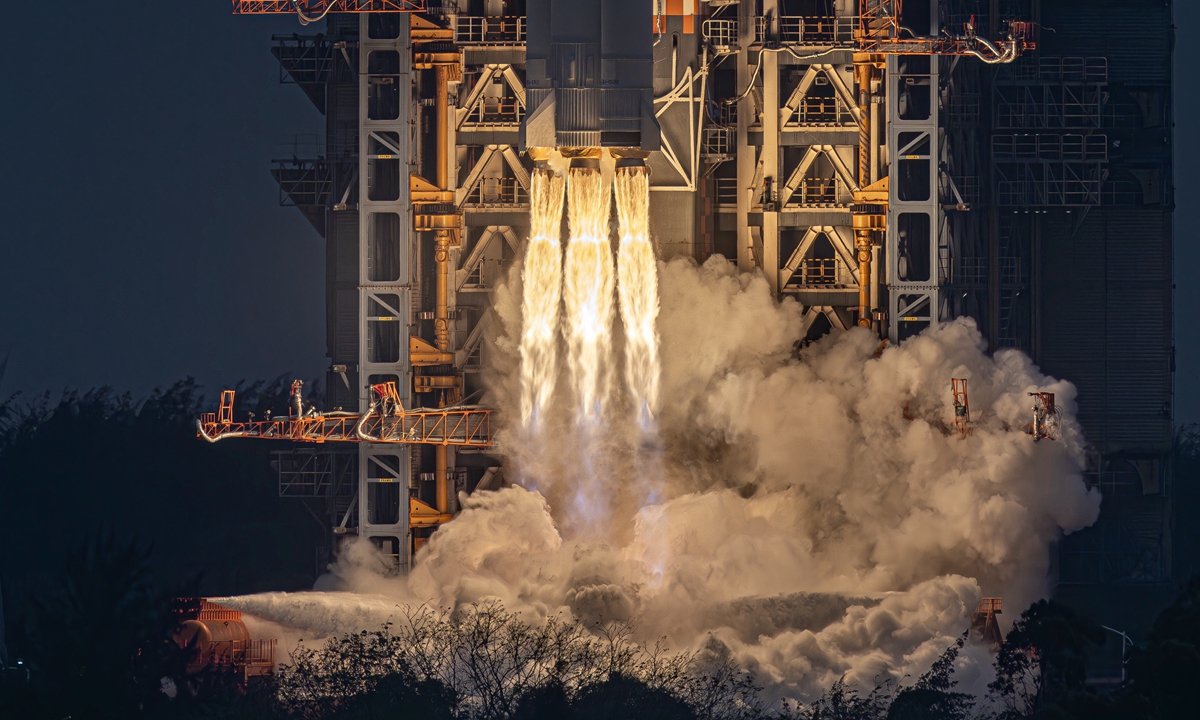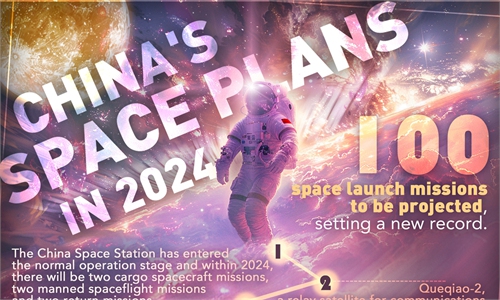China launches Queqiao-2 as key relay communication platform for future lunar missions

Photo: Zhang Jingyi
China on Wednesday successfully launched into preset orbit the Queqiao-2 relay communication satellite as well as Tiandu-1, Tiandu-2 communication and navigation technology experiment satellites, the key constellation supporting the country's subsequent Chang'e lunar exploration missions as well as international exploration programs.
Carrying the three satellites, a Long March-8 rocket took off from Wenchang Space Launch Site in South China's Hainan Province at around 8: 31 am on Wednesday. And after a flight of 24 minutes, the Queqiao-2 satellite separated from the carrier rocket and then its solar wings and communication antennas unfolded normally, marking the complete success of the launch mission, according to the China National Space Administration (CNSA).
Queqiao-2, or Magpie Bridge-2, is a relay satellite for communications between the far side of the moon and the Earth. The satellite will serve as a relay platform for the fourth phase of China's lunar exploration program, providing communications services for Chang'e-4, Chang'e-6, Chang'e-7, and Long March-8 missions.
The satellite is named after the Chinese mythological term "Magpie Bridge," which refers to a bridge formed by the winds of a flock of magpies for the once-a-year meeting of Zhinü (Weaver Girl), the seventh daughter of the Jade Emperor and Queen Mother of Heaven, and her mortal lover Niulang (Cowherd).
Compared to the Queqiao-1 relay satellite launched with the Chang'e-4 lunar mission in 2018, the Queqiao-2 relay satellite features more technological innovations, a broader range of technical capabilities, enhanced functionalities, more complex interfaces, higher development complexity, and a longer mission time span. Additionally, Queqiao-2 carries multiple scientific payloads and will conduct scientific exploration missions, per the CNSA.
The CNSA also highlighted on Wednesday that the Queqiao-2 relay satellite would provide services for subsequent lunar probe missions, both Chinese and international ones.
And 120 seconds after the separation of Queqiao-2 relay satellite, the Tiandu satellite combination separated from the relay satellite and entered a direct Earth-moon transfer orbit with a near-point altitude of 200 kilometers and a far-point altitude of 420,000 kilometers, the Tiandu program contractor Deep Space Exploration Lab (DSEL) revealed in a statement it provided to the Global Times on Wednesday.
Subsequently, with ground control support, Tiandu satellites will undergo mid-course corrections and near-moon braking to enter a capture orbit, the DSEL confirmed.
Then, under orbit control, it will enter a 24-hour period elliptical lunar orbit, following which the two satellites will separate, and the relative distance will be adjusted to about 200 kilometers to conduct new technology verifications such as lunar orbit navigation, integrated Ka-band communication ranging, and high-reliability transmission and routing between moon and Earth, the DSEL disclosed.
The twin satellites, weighing 61 kilograms and 15 kilograms respectively, were separately developed by the Shanghai Academy of Spaceflight Technology and the Harbin Institute of Technology, per the DSEL.
During the short half-hour flight, the Long March-8 rocket demonstrated three tailored capabilities for the Queqiao-2 relay satellite mission: enhanced trajectory design, more flexible active roll control technology, and improved thermal protection measures for safety, the rocket model developer China Academy of Launch Vehicle Technology (CALT) told the Global Times in a statement on Wednesday.
According to the CALT, the Wednesday mission was the third flight of the Long March-8 rocket. In 2020, it successfully debuted, filling the gap in China's ability to carry 3-5 tons to Sun-synchronous orbit. In 2022, it adapted to commercial launch missions with "one rocket, 22 satellites" without two boosters.
"Today, the Long March-8 rocket embarked on its first journey to the Earth-moon transfer orbit, once again proving its stability, reliability, and adaptability through successful performance," read the CALT statement.
Mounting a nose cone with 4.2 meters in width and 8 meters in height, the rocket that can send payload no less than 1.3 tons to the Earth-moon transfer orbit is considered as a perfect match for the Queqiao-2 satellite launch mission.
Compared to the tasks Long March-8 rocket excels at executing in Sun-synchronous orbit, the Earth-moon transfer orbit has a lower insertion altitude and faster rocket flight speed, almost reaching the second cosmic velocity. As the rocket rapidly crosses the atmosphere, the temperature generated by friction between the rocket body and the atmosphere is higher, especially affecting the nose cone and front end, CALT explained.
To address this challenge, the rocket development team added an extra layer of thermal protection coating to the rocket. Although it may not be apparent from the exterior, key parts of the rocket have increased thickness, enhancing its ability to withstand the harsh conditions of the Earth-moon transfer orbit, it said.
To meet the future demand for launching large-scale constellations in low Earth orbit, the modified Long March-8 carrier rocket will undertake its maiden flight mission at the Wenchang Space Launch Site in Hainan in the latter half of this year, the Global Times has learned from CALT.
The Chang'e-6 mission, set to launch in the first half of this year, aims to break new ground in lunar retrograde orbit design and control, intelligent sampling on the moon's far side, and ascent from the lunar surface. It will conduct an automated sample return from the moon's far side, along with scientific exploration of the landing area and international collaboration, according to the CNSA.
Wu Weiren, chief designer for China's lunar exploration program, had previously revealed that Stage 4 Chang'e lunar probe missions the Chang'e-6, Chang'e-7 and Long March-8 will carry out new planetary exploration missions and further upgrade the country's space launch capabilities in the next 15 years.


